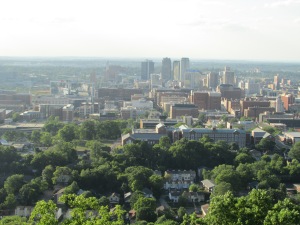In this overly contentious and troubling time, it’s refreshing to see people take to LinkedIn to quibble over the pronunciation of a simple word.
Stuckey’s, the iconic roadside chain of highway stops (www.stuckeys.com), was a constant in my family travels growing up, especially on trips to the Gulf coast. It was a true roadside attraction, offering pecan-based treats, fast food and sodas, souvenirs, gasoline, and convenient (and usually clean) restrooms.
While the chain is best known for its exceptional pecan products, I was always partial to the sweet “fruit slice” candies that could usually be found. The last time I was in a Stuckey’s store, I was amused that the souvenirs seemed to be from every state – not just the state I was in.
W.S. and Ethel Stuckey of Eastman, Georgia, founded the brand in the 1930s. Their first location was a way to sell the Stuckey pecan crop. Soon, Mrs. Stuckey began to add to the offerings with things like divinity and pralines and, most notably, her special creation – the pecan log roll.
W.S. and Ethel’s granddaughter, Stephanie Stuckey, is the new CEO of Stuckey’s. Ms. Stuckey has launched an effort to locate and reclaim old Stuckey locations and rejuvenate the brand. As part of that effort, she has posted memories and details of her project. She has captured many imaginations along the way.
Among my favorite posts is the one in which she tells how her grandfather would fuel up with coffee and start driving the highways. When he had to stop for a restroom break, he would decide that was a good spot for another Stuckey’s store.
Recently, Ms. Stuckey posted what appears to be a vintage Stuckey’s ad with beautiful shiny pecans and the caption “It’s ‘PEE-CAN’.”
Cue the floodgates. People began to post reactions and support their side of the pecan pronunciation debate – a conflict that will never go away in the South. A commentary from a North Carolina man declared fervently that “PEE-CAN is the correct pronunciation!” and went on to say that any Southerner ought to know that and that those of us who say it any other way sound like Thurston Howell III on “Gilligan’s Island.”
I try not to jump into any fray these days, but I had to respond: “My Alabama family says ‘puh-KAHN’ and none of us sound like Thurston Howell. Also, Georgian Jimmy Carter, the epitome of a native Southerner, says ‘puh-KAHN.’ I bet you put peanuts in Pepsi — a sacrilege! Peanuts must go in Coca-Cola.”
I was enjoying the entertaining thread and had to stoke the fire by making reference to the old tradition – presumably Southern – of emptying part of a sleeve of salty peanuts into a bottle of soda, specifically Coca-Cola. Theories abound that the tradition was a convenient fast snack for blue collar workers or workers in the field in the early 20th Century. I had never known, until I saw it on a cooking show, that some people – North Carolinians, in particular – traditionally used Pepsi Cola instead of Coke for that down-home snack which I used to enjoy as a child. I guess it might work with Pepsi instead of Coke, but I will stick to Coca-Cola.
Still, the crux of the responses to the Stuckey ad was the acceptable pronunciation of “pecan.” Southern Living magazine has listed six variations on the pronunciation:
pah-KAHN; puh-CAN; PEE-can; PEE-kahn; pee-KAHN; and pee-CAN
I will be gracious and say that none of those are wrong, although I grew up hearing that a “pee-can” was something one kept in the car for emergencies on long trips. Or alongside the slop jar under the bed.
Most Georgians I know say “pee-CAN.” The aforementioned President Carter is a notable exception. I can’t think of any Alabamians I know who say anything other than “puh-KAHN,” and that includes some farmers who harvest and sell the nut. Priester’s Pecans in Fort Deposit, my favorite Alabama purveyor of pecan products (www.priesters.com), endorses the “puh-KAHN” pronunciation.
Pre-Pandemic, when I taught Voice and Diction classes, I would use “pecan” as an example of one of those words that has a variety of acceptable pronunciations. It isn’t necessarily even a detail of geography; I think it just has to do with who raised you. Like individual tastes in barbecue and cornbread, it has more to do with what one is familiar with and what one grew up with, and questions of relative quality become superficial.
For the record, though: I don’t accept the notion of sugar in cornbread; my barbecue tastes lean toward pork with vinegar-based sauces; I am still opposed to white barbecue sauce; and the old “peanut and soda” routine only works with a Coca-Cola.
I’m grateful to Stephanie Stuckey for giving me a pleasant distraction in difficult times. I am fully behind her ongoing crusade to reclaim and refurbish former Stuckey’s. Since I discovered her posts, I have been on the lookout for abandoned or rebranded Stuckey’s locations. I captured two as I travelled north on I-65 in Alabama this afternoon.
Stuckey’s is authentic, real-deal Americana. Its resurgence is a welcome antidote to the manufactured fake nostalgia of places like Cracker Barrel. I want a pecan log roll with a side of sugary “fruit slices,” and I want them now!








